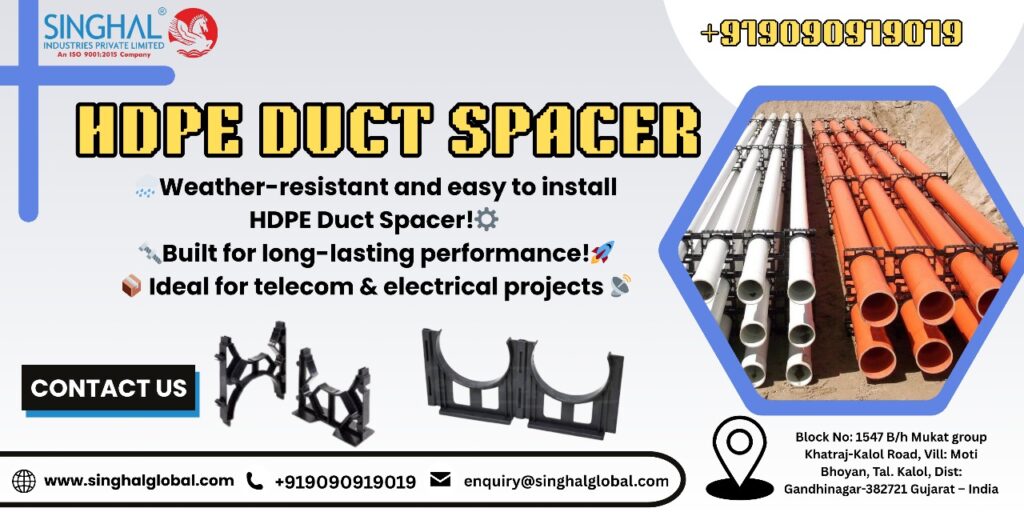In a world that is constantly being surrounded by buzzing power lines and inscrutable fiber-optic signals, very few people think about how they keep all these underground cables in order and protected in a way that is safe for our feet. The unnoticed hero? HDPE duct spacers. These tiny, often overlooked plastic components are vital to keeping the quality as well as alignment of underground conduit systems, particularly in the telecom and power industries. If you’re installing fiber cables to connect an innovative city project or running high-voltage lines to support city development, these small tools can make a huge difference.
Let’s explore this world of HDPE spacers for ducts — what they are, what they do, how important they are, and how they aid huge infrastructure systems across India and the world.
The Backbone for Subterranean Cable Management
Ask any utility engineer or cable installer how they keep the underground systems for ducting secure and effective, and the chances are they’ll refer to spacers for ducts. Made of high-density polyethylene (HDPE), these rigid plastic supports are positioned between ducts during trench installation to ensure a consistent alignment and spacing. Imagine a ducting system that is laid on top of one another. Without the proper spacing, they could fall apart under pressure, move due to movements in the soil, or experience heat stress due to poor air circulation.
Why HDPE?
The answer lies in durability. HDPE (high-density polyethylene) is a chemically inert and non-corrosive material that is known for its long lifespan, light structure, and incredible strength. In India’s varied climates, ranging from the humid beaches in Kerala to the dry Rajasthan regions, HDPE will not crack when pressure is applied or lose its shape when wet. It’s the reason why duct spacer producers have a majority of their customers choosing HDPE instead of alternatives such as PVC or metal.
Realism and Its Impact on the World: An Example Study from Pune
In 2022, as part of the major fiber optics extension project that was taking place in Pune, a renowned telecom company opted to use premium HDPE duct spacers, which came from one of the most reputable duct spacer suppliers in India. This decision was a success. The project not only had a 35% reduction in installation time because of the ease of setting up spacers, but the engineers also had no alignment issues, which frequently delay inspections.
The Economic Angle: Understanding the Duct Spacer Price
In the eyes of many managers and project leaders, the price of infrastructure elements is a constant factor to consider. The Duct spacer price varies with diverse factors which include the nature of the material, size, weight supporting ability alongside the design complexity. The truth is that cutting corners on quality in order to save just a few dollars could result in a higher cost in the end. Incorrectly aligned spacers can lead to tension on cables, misalignment, or even complete failure of specific installations. Imagine digging a trench again due to ducts breaking, which is costly. A reputable Duct spacer manufacturer in India provides a variety of types and styles that allow you to manage the cost and performance. It’s not all about buying the lowest price, but rather investing in reliability over the long term.
Created to Serve Telecom and Power Needs
In telecom, the spacing of ducts helps ensure signal stability, minimizes cross-talk between cables, and assists with future cable upgrades or pulling. In the case of power cables specifically for high-voltage applications, the proper spacing helps prevent overheating and also protects the wires from interference by electromagnetic waves. Certain HDPE spacers are equipped with integrated locks, designs that stack, or indicators that are pre-marked, making them more convenient to set up and quicker, saving time and effort.
The Green Side: Green Manufacturing
Many of the top Duct spacer suppliers in India currently offer recycled HDPE spacers, which are in line with the increasing awareness of environmental concerns. These products don’t just decrease emissions from utility-scale projects, but also help to achieve sustainable certifications for infrastructure bids. In fact, specific tenders are now specifically seeking products that have less environmental impact, which gives eco-friendly suppliers an advantage.
Installation Made Easy
What is the most frequently neglected advantage of spacers made out of HDPE to use with ducts? They can be installed with ease. In contrast to metal or concrete support structures, HDPE spacers are light and simple to align manually and do not require any special tools. This means they can be installed faster and with less labor intensity, which is particularly useful in hilly or remote terrains. In regions such as Himachal or Uttarakhand, in which trenching is difficult due to uneven terrain, ducts that are easy to handle spacers are game changers.
Conclusion
It’s easy to forget about spacers in ducts. They’re not extravagant, costly, or even noticeable after installation. But don’t forget: their function is crucial. In a time when India is expanding rapidly, its digital network and modernizing electrical grids, parts such as HDPE spacers for ducts are quietly taking on the heavy lifting underground. If you’re an engineer, contractor, or a procurement manager, it’s beneficial to work with reliable duct spacer suppliers in India who know the complexities of the climate, terrain, and project size. When you’re evaluating the Duct spacer price, do not just focus on the cost, but also consider value, durability, and support.
Frequently Asked Questions (FAQs)
Q1. What is the length of time HDPE spacers in ducts last?
HDPE spacers for ducts are famous for their outstanding longevity. If properly installed, they will last for 20 to 50 years or longer, based on the soil conditions and the load pressure. Their non- corrosive and weather-resistant properties are ideal for long-term use underground.
Q2.What are the sizes of HDPE duct spacers that are available?
HDPE duct spacers can be found in a range of sizes. They are often tailored to accommodate 32mm, 50mm, 110mm, 63mm, and many more. The sizes can be customized from the top duct spacer makers according to your particular cable configuration. You can pick different sizes and heights for your stacks, for example, 2-way or 3-way, 4-way, and so on.
Q3.What is the maximum load that an HDPE spacer in a duct is able to handle?
The capacity to bear loads of an HDPE spacer for ducts depends on the design and the thickness. In general, they are designed to withstand substantial pressure in both horizontal and vertical directions sufficient to take on the compacted soil, traffic load over trenches, and small shifts in the ground. They are also available in heavy-duty versions for roadside and industrial installations.
Q4.Do HDPE spacers reduce cable damage risk?
Absolutely. Absolutely. HDPE duct spacer is able to minimize the friction in cables, pressure points, friction, and misalignment by maintaining perfect alignment and spacing. These are the principal reasons of the cable damage during the installation and after the installation.









